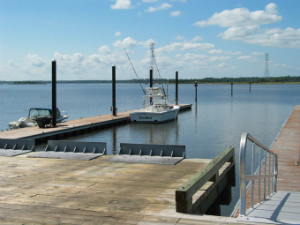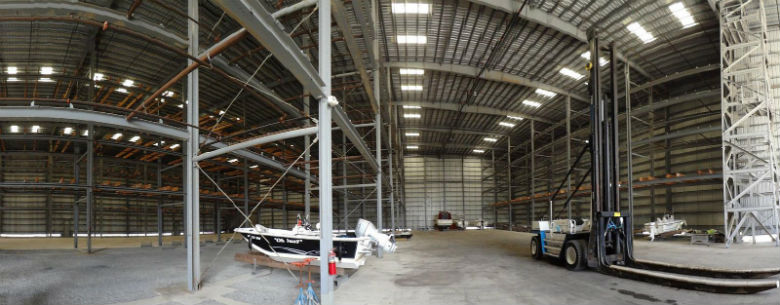 Watermark Marina hopes to extend their pier further into the Cape Fear River so that boaters have deep water access. Photo: Wilmington Regional Film Commission. |
WILMINGTON – Watermark Marina offers a host of amenities as an event space: a reception hall with waterfront views, a private pool and a manicured lawn that stretches to the banks of the Cape Fear River.
Yet a majority of the more than 400 dry slips at the marina remain empty because Watermark’s boat launching pier is in water so shallow boaters who use the facility are limited to a small window of opportunity each day to access the river.
Supporter Spotlight
The marina’s owners believe the problem may be remedied by extending the 540-foot pier farther into river, a move that will require a modification to their state permit and one the N.C. Division of Coastal Management has, for a second time in recent weeks, denied.
It’s now up to the N.C. Coastal Resources Commission, which convenes for a two-day meeting beginning today in Beaufort, to decide whether to grant a modification to the marina’s Coastal Area Management Act, or CAMA, major permit.
Coastal management officials last December rejected a request by CXA-10 Corporation, the Texas-based investment holdings company that owns the marina, a variance necessary to extend the pier by more than 1,000 feet. The proposed expansion would usurp about 1.36 acres of public trust area.
The Division of Coastal Management concluded that the company’s proposal to lengthen the pier would be inconsistent with the Coastal Resources Commission’s “1/4 width rule,” a regulation that limits the construction of piers and docks from extending more than one-fourth the width of a natural water body, human made canal or basin.
Division officials also determined that lengthening the pier would not be in keeping with what is known as the “rate to deep water” rule, which allows piers to exceed the 400-foot limitation “only if the proposed length gives access to deeper water at a rate of at least 1 foot for each 100 foot increment of length longer than 400 feet.”
Supporter Spotlight
The pier is located in a state-designated estuarine primary nursing area, or PNA. Dredging is prohibited in PNAs.
During their meeting in May, members of the Coastal Resources Commission held off on voting on the company’s request, instead unanimously agreeing to allow CXA-10 to conduct a new depth survey, updating one completed in 2010.
The 2010 survey looked at extending the pier to a depth of 6 feet above the mean low water line, meaning that six feet of water would be at the pier’s edge at low tide.
Wilmington attorney Bill Raney Jr., who represents CXA-10, told the commission in May that his client would agree to build to five feet above the mean low water line, shaving the proposed pier length by between 150 feet and 200 feet, according to state documents.
 The dry stack is empty in this photo taken soon after the marina was built. A majority of the slips remain empty due to the lack of deep water access. Photo: Wilmington Regional Film Commission |
That change would cut the proposed pier length from 1,424 feet to 1,306 feet, according to the latest survey, which was conducted in June. This reduces the width at which the pier would span into the channel from 53 percent to 49 percent.
“It’s a 118-foot reduction of the structure they had proposed,” said Rob Mairs, a field representative with Division of Coastal Management’s Wilmington regional office.
If the pier were to be extended to five feet below the mean low water line it would gain deeper water at a rate less than .5 feet per 100 foot increment.
“That’s not going to make a significant difference,” Mairs said. “Based on the surveys that we’ve seen it doesn’t look like there’s been much of a change since 2010. We’re still holding the same position.”
In its original petition to the Coastal Resources Commission, the marina’s owner argued that extending the pier “will not result in unreasonably restricting navigation or interfering with other public uses of the public trust waters.”
“Honest mistakes by both the developers of the property and the Division of Coastal Management resulted in permitting a substantial dry storage marina that is of little practical use,” according to CXA-10 Corporation’s petition to the commission.
 Frank Gorham |
A CAMA major permit was issued in May 2001 to Barnards Creek, LLC, the marina’s owners at the time, to build a 540-foot launch pier at the site, which is a little more than four miles south of the Cape Fear Memorial Bridge in Wilmington.
It wasn’t until after the pier and floating docks were built in late 2005 and early 2006 that the owners discovered launching and retrieving boats there was limited to four out of every 12 hours.
In 2008, the marina filed for Chapter 11 bankruptcy protection. The marina’s owner was forced to sell its assets, auctioning off everything from boats and kayaks to furniture in March 2010.
About two months after the auction, CXA-10 Corporation bought the property through a foreclosure sale. The owner of the corporation is a Texan banker named Andrew Beal who is well known for making his billions by scooping up assets during financial crisis, turning them around and making a profit.
If the Coastal Resources Commission accepts the state’s recommendation and denies the permit variance request, the company could take the matter to court.
For that reason, Raney declined to comment.
“It’s a quasi-judicial proceeding so it would be inappropriate for me to comment at this time,” he said.
The commission’s chairman Frank Gorham agreed.
“We can’t talk about variances because they’re still subject to review,” he said. “If we’ve had a variance and they want to appeal it to a district court we shouldn’t talk about it. It’s just a smart policy.”
The commission is scheduled to discuss the variance request this afternoon at the National Oceanic and Atmospheric Administration Auditorium, 101 Pivers Island Road, Beaufort.
Update: Variance denied
At their meeting on July 30, the Coastal Resources Commission denied the permit variance to the marina.







